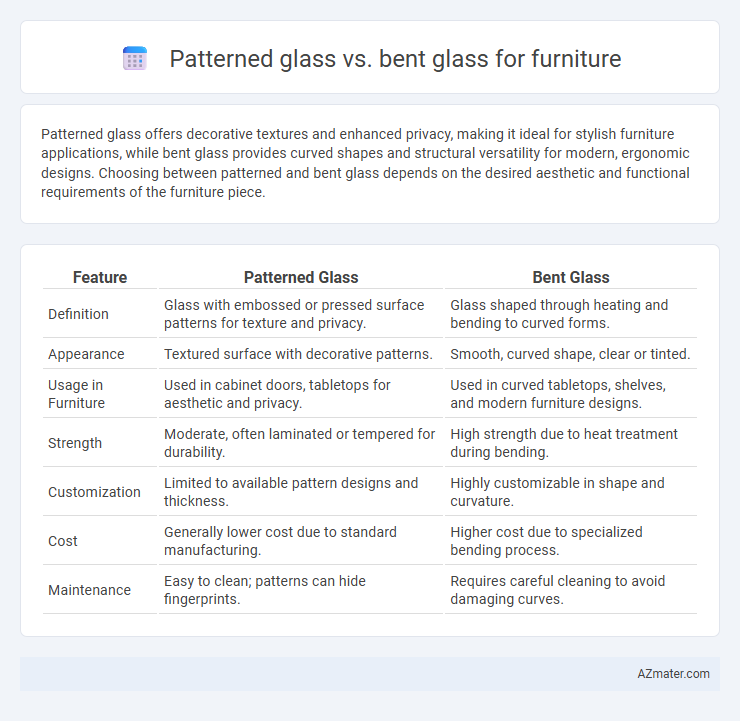Patterned glass offers decorative textures and enhanced privacy, making it ideal for stylish furniture applications, while bent glass provides curved shapes and structural versatility for modern, ergonomic designs. Choosing between patterned and bent glass depends on the desired aesthetic and functional requirements of the furniture piece.
Table of Comparison
| Feature | Patterned Glass | Bent Glass |
|---|---|---|
| Definition | Glass with embossed or pressed surface patterns for texture and privacy. | Glass shaped through heating and bending to curved forms. |
| Appearance | Textured surface with decorative patterns. | Smooth, curved shape, clear or tinted. |
| Usage in Furniture | Used in cabinet doors, tabletops for aesthetic and privacy. | Used in curved tabletops, shelves, and modern furniture designs. |
| Strength | Moderate, often laminated or tempered for durability. | High strength due to heat treatment during bending. |
| Customization | Limited to available pattern designs and thickness. | Highly customizable in shape and curvature. |
| Cost | Generally lower cost due to standard manufacturing. | Higher cost due to specialized bending process. |
| Maintenance | Easy to clean; patterns can hide fingerprints. | Requires careful cleaning to avoid damaging curves. |
Introduction to Patterned Glass and Bent Glass
Patterned glass features textured surfaces created through rolling or embossing techniques, enhancing privacy and decorative appeal in furniture applications. Bent glass is formed by heating flat glass until pliable, then shaping it into curved designs that add sleek, modern aesthetics and structural strength. Both types offer unique functional and visual benefits for custom furniture solutions, with patterned glass emphasizing texture and light diffusion while bent glass highlights smooth contours and durability.
Material Properties: Patterned vs Bent Glass
Patterned glass features textured surfaces that enhance durability by distributing stress and reducing visible scratches, making it suitable for decorative furniture applications. Bent glass is heat-treated and curved, offering increased strength and flexibility, ideal for modern furniture designs requiring smooth, continuous shapes. Both materials provide distinct mechanical properties, with patterned glass emphasizing surface resilience and bent glass focusing on structural integrity and aesthetic fluidity.
Manufacturing Processes Compared
Patterned glass manufacturing involves rolling molten glass through engraved rollers to imprint textures, enhancing privacy and aesthetic appeal while maintaining flatness. Bent glass production uses heat bending, where flat glass is heated to its softening point and shaped over molds, enabling curved forms ideal for modern furniture designs requiring unique contours. The primary distinction lies in patterned glass's embossing technique versus bent glass's thermal shaping, influencing cost, design flexibility, and structural characteristics in furniture applications.
Aesthetic Appeal and Design Flexibility
Patterned glass offers unique textures and decorative designs that enhance aesthetic appeal, creating a visually striking surface ideal for accentuating furniture pieces. Bent glass provides superior design flexibility with its curved shapes and seamless edges, allowing for innovative and ergonomic furniture designs that maximize space and style. Combining both materials can result in customized furniture that balances ornamental detail with modern, fluid forms.
Durability and Strength Differences
Patterned glass features textured surfaces that enhance scratch resistance but generally offers lower structural strength compared to bent glass. Bent glass undergoes heat treatment and shaping processes that increase its durability and impact resistance, making it more suitable for load-bearing furniture components. Choosing bent glass over patterned glass ensures superior resilience and safety in high-stress applications.
Functional Applications in Furniture Design
Patterned glass enhances furniture design by providing textured surfaces that increase privacy and diffuse light, making it ideal for cabinet doors, shelves, and partitions where concealment and aesthetic appeal are important. Bent glass offers structural versatility with its curved form, enabling the creation of sleek, modern furniture pieces such as curved table tops and seamless glass displays that emphasize fluidity and space efficiency. Both types improve functionality: patterned glass combines decorative effects with practical screening, while bent glass supports innovative shapes and ergonomic designs in contemporary furniture.
Light Diffusion and Privacy Features
Patterned glass offers enhanced light diffusion through textured surfaces that scatter light evenly, reducing glare while maintaining privacy by obscuring direct visibility. Bent glass, shaped through heating and molding processes, provides a sleek curved aesthetic but generally allows more transparent light transmission with less diffusion, offering minimal privacy compared to patterned options. Choosing patterned glass for furniture prioritizes privacy and soft illumination, whereas bent glass emphasizes design fluidity with clearer visibility.
Cost Analysis: Patterned Glass vs Bent Glass
Patterned glass generally costs less than bent glass due to its simpler manufacturing process, which involves embossing patterns onto flat sheets without altering the glass shape. Bent glass requires specialized heating and bending equipment, increasing labor and production expenses. When selecting glass for furniture, factoring in these cost differences is essential for budget optimization while maintaining aesthetic appeal.
Maintenance and Cleaning Considerations
Patterned glass for furniture requires gentle cleaning with non-abrasive cloths and mild detergents to prevent damage to its textured surface, while bent glass benefits from smooth surfaces that are easier to wipe clean with standard glass cleaners. Avoid harsh chemicals or abrasive tools on patterned glass as they can erode the intricate designs and cause dullness. Bent glass maintenance emphasizes preventing scratches and chips since the curved shape may be more vulnerable to physical impacts during cleaning or use.
Choosing the Right Glass for Your Furniture
Patterned glass offers textured surfaces that enhance privacy and hide imperfections, making it ideal for decorative furniture like cabinets and tabletops. Bent glass provides sleek, curved designs that add modern elegance and structural integrity to furniture such as shelves and desks. Selecting between patterned and bent glass depends on the desired aesthetic, durability, and functional requirements of the furniture piece.

Infographic: Patterned glass vs Bent glass for Furniture
 azmater.com
azmater.com